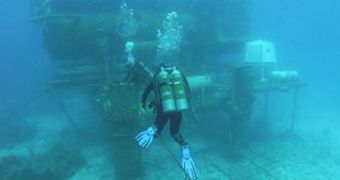NASA astronauts are preparing for manned missions on the Moon and possibly even on Mars in a more earthly environment. An underwater lab provides the best and least expensive training grounds due to the increased density and lift force water provides.
Located 18 meters (6 feet) under the surface, the lab is testing the astronauts' abilities to move around and perform various maintenance and medical tasks in simulated low gravity. The astronauts are also surrounded by friendly sharks and curious sea turtles that examine the "aquanauts."
Astronaut Jose Hernandez and NASA flight surgeon Josef Schmid are imitating the lunar-like slow-motion leaps of Neil Armstrong, caused the Moon's gravity, one sixth that of the Earth, as they assemble a tubular structure on the ocean floor.
A medical experiment was carried out inside the Aquarius Underwater Laboratory, where two robotic arms remote controlled from thousands of kilometers away performed surgery on a simulated patient. The crew is made up of two astronauts, a flight surgeon, a university doctor and two technicians, who have made the underwater lab their home for a period of 12 days.
The lab itself is a coral-encrusted cylinder that looks a lot like a yellow submarine, located 5.5 kilometers (3.4 miles) off Florida's Key Largo and it's the only underwater laboratory in the world, as close as NASA could get to replicating space conditions.
"We classify this as an extreme environment," said Todd of the United Space Alliance, which operates NASA's space shuttle fleet.
Medical experiments are of utmost importance, since in space latent viruses in the bodies of the astronauts replicate far more rapidly than on Earth, so researchers are trying to find out what causes the viruses to multiply so fast in space and how could the process be dealt with.
"There's no other place we know of where we'd get this kind of response," said Todd, sporting a mission T-shirt that proclaims: "It's one small fin kick for a man, one giant stride for mankind."
This experiment, part of NASA's Extreme Environment Mission Operations (NEEMO) program, is one of the many designed to address critical issues of a manned flight to the Moon and later to Mars.

 14 DAY TRIAL //
14 DAY TRIAL //